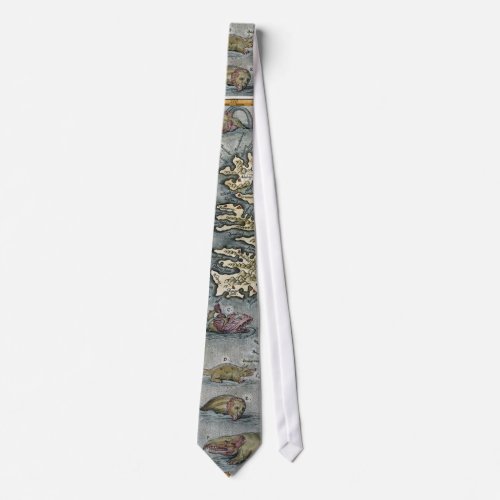Ortelius Map Sea Monsters Tie



From the map: A. is a fish, commonly called NAHVAL. If anyone eats of this fish, he will die immediately. It has a tooth in the front part of its head standing out seven cubites. Divers have sold it as the Unicorn's horn. It is thought to be a good antidote and powerful medicine against poison. This monster is forty ells in length. B. the Roider is a fish of one hundred and thirty ells in length, which has no teeth. The flesh of it is very good meat, wholesome and tasty. Its fat is good against many diseases. C. The BURCHVALUR has a head bigger than its entire body. It has many very strong teeth, of which they make chess pieces. It is 60 cubites long. D. The Hyena or sea hog is a monstrous kind of fish about which you may read in the 21st book of Olaus Magnus. E. Ziphius, a horrible sea monster that swallows a black seal in one bite. F. The English whale, thirty ells long. It has no teeth, but its tongue is seven ells in length. G. HROSHUALUR, that is to say as much as Sea horse, with manes hanging down from its neck like a horse. It often causes great hurt and scare to fishermen. H. The largest kind of Whale, which seldom shows itself. It is more like a small island than like a fish. It cannot follow or chase smaller fish because of its huge size and the weight of its body, yet it preys on many, which it catches by natural cunning and subtlety which it applies to get its food. I. SKAUTUHVALUR. This fish is fully covered with bristles or bones. It is somewhat like a shark or skite, but infinitely bigger. When it appears, it is like an island, and with its fins it overturns boats and ships. K. SEENAUT, sea cow of grey colour. They sometimes come out of the sea and feed on the land in groups. They have a small bag hanging by their nose with the help of which they live in the water. If it is broken, they live altogether on the land, accompanied by other cows. L. STEIPEREIDUR, a most gentle and tame kind of whale, which for the defence of fishermen fights against other kinds of whales. It is forbidden by Proclamation that any man should kill or hurt this kind of Whale. It has a length of at least 100 cubites. M. STAUKUL. The Dutch call it Springual. It has been observed to stand for a whole day long upright on its tail. It derives its name from its leaping or skipping. It is a very dangerous enemy of seamen and fishermen, and greedily goes after human flesh. N. ROSTUNGER (also called Rosmar) is somewhat like a sea calf. It goes to the bottom of the sea on all four of its feet, which are very short. Its skin can hardly be penetrated by any weapon. It sleeps for twelve hours on end, hanging on some rock or cliff by its two long teeth. Each of its teeth are at least one ell long and the length of its whole body is fourteen ells. O. Spermaceti parmacitty or a simple kind of amber, commonly called HUALAMBUR. P. Blocks and trunks of trees, by force of winds and violent tempests torn off by their roots from the cliffs of Norway, tossed to and fro, and surviving many storms, finally cast upon and coming to rest at this shore. Q. Huge and marvellously big heaps of ice, brought here by the tide from the frozen sea, making loud and terrible noises. Some pieces are often as big as forty cubits. On some of these, white bears sit together, watching the innocent fish play about in exercise.


